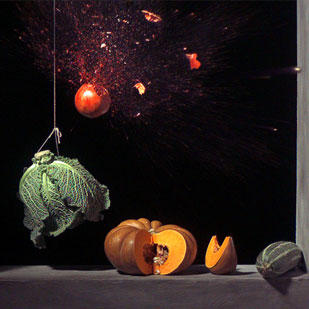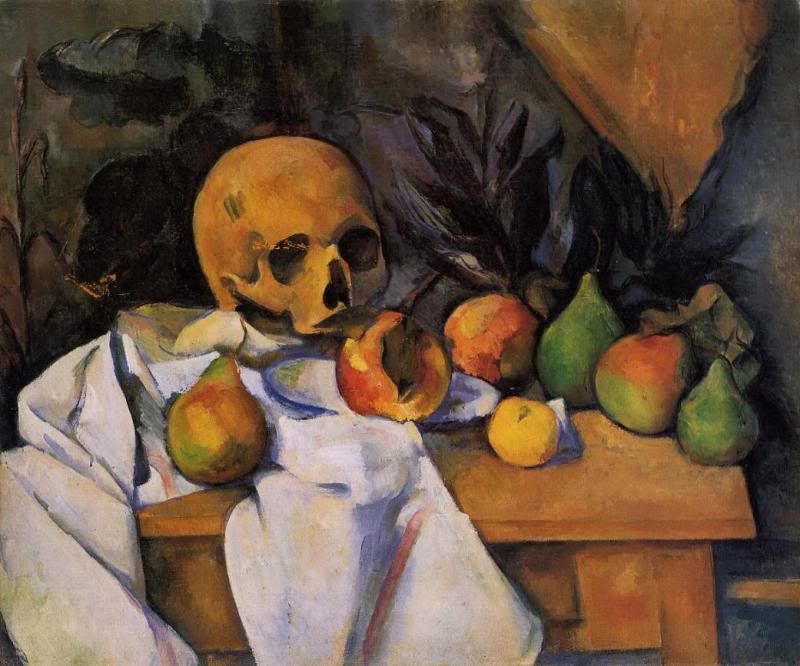Friday, March 5, 2010
drawing video
I enjoyed the drawing video. I like how it interviewed various artists and showed some of their works that had to do with the different types of drawing. It was interesting to see all the different ways that artists can make drawing "their own". I did not have a favorite artist, as i thought all of the artists works that were shown were all unique in their own way which was cool. what i found interesting was where each artist's studio was. some were inside what looked like their house, others appeared to be in their garage and one looked like he was in an attic. I just found it interesting the different locations they all worked in. overall it was a very educational video about drawing and how much variety there is within it.
Tuesday, March 2, 2010
Still Life: Fruit

Severin Roesen painted this in 1855. His works were almost always of fruits and wine glasses and this work really demostrates his flawless craftsmanship. His meticulous attention to detail draws the eye all over the feast as if tempting the audience to take a piece or contemplate which they would take if they could. I love how every grape has a shine to it and how the center of the piece (the white grapes) contrasts greatly from the dark background. I think it attracts the most attention and then the eye wanders to the other fruits that fade into the background.
Still life
 This picture is by Juan Gris and is rendered in pencil on paper. I decided on this one because of the none traditional way he composed such a traditional piece. Using the fruit as the center of your still life is very common, but the use of shading and the way the edges are jagged is very interesting. To take such a common kind of picture and change it so the audience wants to look and dissect it, that is what makes a great work of art.
This picture is by Juan Gris and is rendered in pencil on paper. I decided on this one because of the none traditional way he composed such a traditional piece. Using the fruit as the center of your still life is very common, but the use of shading and the way the edges are jagged is very interesting. To take such a common kind of picture and change it so the audience wants to look and dissect it, that is what makes a great work of art.

A very famous piece by Vincent van Gogh relates well with the still life topic that we are now discussing in class. This painting is titled Sunflowers (Still Life: Vase with Fifteen Sunflowers) 1888. Van Gogh's painting is a very different example of still life, in that it as not as realistic as what usually comes to mind when thinking about a still life piece of artwork. He doesn't use much shading or different tonalities under the vase, which is what causes it to be less successful as a realistic piece, but very successful as a piece that is fun to interpret. I especially like the fact that the flowers are all so different from one another, even though there are only really two species of flowers in the pot. Each one is distinctly different from the others and all are going in different directions. The fact that some are drooping down makes the eye of the audience go down as well and almost makes a sense of sadness in a way, even though sunflowers are known to be bright and cheery. Overall, this piece is not as commonplace in the "still life world", but is easily recognized as a great piece of van Gogh's.
 I thought this was an awesome piece by Juan Sanchez Cotran a painter during the Spanish Baroque era in the late 1500's. This piece really caught my attention as the picture of the tomato breaking in the air looks so real. All the little particles displacing everywhere is really interesting and I wonder how he accomplished doing that. The picture directs your attention from the broken tomato to the still and calm part of the bottom of the picture.
I thought this was an awesome piece by Juan Sanchez Cotran a painter during the Spanish Baroque era in the late 1500's. This piece really caught my attention as the picture of the tomato breaking in the air looks so real. All the little particles displacing everywhere is really interesting and I wonder how he accomplished doing that. The picture directs your attention from the broken tomato to the still and calm part of the bottom of the picture.
Kiril Tzotchev
One of my favorite artists is Kiril (Kiki) Tzotchev. He is an experienced sculptor, fine artist and teacher in the classical tradition. Much of his works are on display in various museums in the US and Eastern Europe. I was lucky enough to be one of his students for two years at his Classical Art School in Long Island. He taught me everything from the vital importance of a well-sharpened pencil to the order of placing watercolor on paper. I would come in every class and start drawing whatever he had set up for the day, whether it was a pitcher and fruits or a nude model. I admire his sketches that seem so deceptively easy and yet so perfect in proportion and volume and shading. Our class in Room 114 today reminded me of his studio. Good times :)
Blog Posts for This Week
For this week, I would like you to post your opinion of the short video that Patrick will play in class on 3/5. This response doesn't need to be anything more than a paragraph describing whether or not you liked it, why, and your favorite artist interviewed in the video.
I also wanted to give you a head's up: During the next class, I've asked Patrick to distribute a short feedback form that he will collect. It is an anonymous form that will give you the chance to to give me feedback on the class and my teaching methods. I urge you to provide honest answers as the form will be anonymous, and will help me improve my teaching effectiveness for the remainder of the semester. This form will ask the following questions:
-What would you like to see change about this class? What would you like to continue?
-Do you feel motivated to create and encouraged to succeed?
-Do you feel that the instructor is prepared for class and comes to class with a positive attitude?
-How would you describe the classroom environment?
-What has been your least favorite assignment?
-What has been your most favorite assignment?
-What is your expected grade?
-What grade do you feel you deserve?
-Do you feel the workload in this class is too much? Not enough?
-Have the expectations of this class been made clear to you?
-Any further comments?
Assignment Due Tuesday 3/7
Hello All!
Great job in class today. You made some good progress on the basics of drawing still life.
Just to clarify, there is nothing due this Friday, but I would recommend that you come to class with your composition blocked out so that Patrick can give you advice on your composition. I also wanted to give you an updated written description of what is due Tuesday, 3/7. If you have any questions, talk to Patrick during Friday's class and he'll be able to help you.
Assignment #4:
Using your five thematically related objects, create one still life drawing on a 22" x 30" piece of white paper that will be provided to you during class. Your composition should be chosen deliberately, but whether it is an open or closed composition is up to you. In this drawing, focus on scale and proportion: block out the whole composition, then begin on the shading. In total, this drawing should take you 4-6 hours.
Tips:
-Generally, a successful still life has several different sized objects and a single strong light source.
-When you're measuring your proportions, don't forget to extend your arm, lock your elbow, and use one eye -- then hold up your pencil or charcoal stick and use it as you would a ruler.
-When you're blocking out your still life, simplify everything down to basic forms: for example, if you're drawing a shoe, it should be drawn first as a rectangle.
- Once you're done blocking your composition and the scale and proportions are correct, go back in and add the details.
-If you're having trouble with the shading, squint your eyes-- this can help you identify the light and dark areas.
-Have fun! Drawing still life can be contemplative and relaxing. Your drawings will often be more successful when you're enjoying what you're doing. If you feel yourself getting stressed, try to loosen up, take a break and walk around.
Good luck! I'm very excited to see your work next Tuesday!
Still Life with Skull

This still life by Cezanne really popped out at me. I love the contrast of the healthy, ripe fruit to the old, dry skull. Cezanne doesn't use a lot of detail in this still life and he doesn't need to. Broader strokes, skillfully placed show the motion of the fabric and the depth of the fruit better than small detail could .
Monday, March 1, 2010

Still Life with Two Lemons, a Façon de Venise Glass, Roemer, Knife and Olives on a Table
I had seen this painting during my visit to the Met this past fall. It was one of my favorite paintings form the whole experience. Up close, the detail of the lemon rind and the crystal is perfect. I like that the entire painting is made up of a really soft yellow, and the bright yellow of the lemons acts as the focal point. The half-peeled lemon, the knife and the sideways crystal contain leading lines that lead to the focal point.
Make Up Assignments
I will give you the option of completing one of the below assignments to make up for one missed class. This assignment will be due the first day of class after spring break.
-----------
Choose five subjects to sketch from the list below. Each sketch should take at least 30 minutes and be drawn separately on an 8.5 x 11" piece of paper.
-Something soft
-Something made of glass
-Your unmade bed
-Lunch
-Someone sleeping
-A plant
-The underside of a table
-An interesting wall
-Water
-Something shiny
-A crumpled piece of paper
-Shadows
---------------
Alternately:
Use all the ink from a single pen. Be creative- don't limit yourself to representation; this is about quantity. You will be expected to bring not only the fruits of your labors, but the empty pen as well.
Peaches and Almonds by Pierre Auguste Renoir

1901 oil painting on canvas by the famous French artist is from the Tate collection of Tate Gallery in London. At the first sight it looks like this painting is pretty colourfull however Renoir didn't used that many colours; instead different shadings makes the objects in this case vibrant and real. The fluffy light beige colour and a darker brown background creates nice contrast setting for the main still life objects.
Subscribe to:
Comments (Atom)
